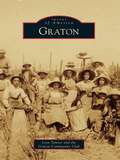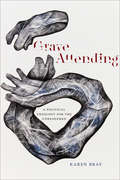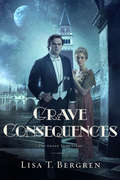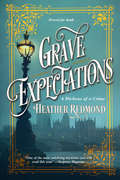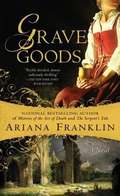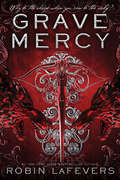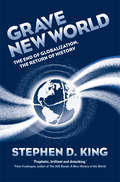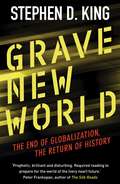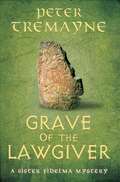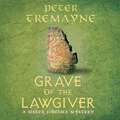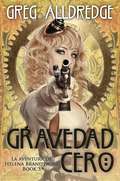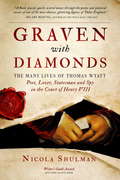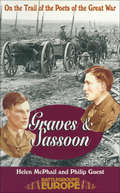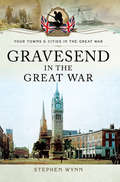- Table View
- List View
Gratitude: Reflections on What We Owe to Our Country
by William F. Buckley Jr.William F. Buckley, Jr., "Mr. Conservative," believes that something must be done to revive our youth's indifference to today's government and politics. In "Gratitude" he offers a plan for universal voluntary national service for men and women 18 years of age and older. Here are his suggestions for how such a program might be structured and administered; on the inducements and sanctions appropriate to its realization; analysis of the benefits, material and spiritual, that would come to those who serve; and an idea of the benefits to those who are served.
Graton
by Lesa Tanner Graton Community ClubThe town of Graton is located in the beautiful and fertile Green Valley, which was first settled in the mid-1800s by pioneer families such as the Sullivans, Gregsons, and Winklers. When the railroad came through the area, realtor James Gray and banker J. H. Brush bought land and created one of the first subdivisions in Sonoma County. They named the streets after themselves and their children, and in 1905, Graton was born. Along with the agricultural industry in California, the town thrived until the 1970s and then declined, only to be reborn in the 1990s. Throughout all Graton's phases, Oak Grove School (1854), the Pacific Christian Academy (1918), and the Graton Community Club (1914) remained vital. Graton is now part of a premiere wine-growing region, and visitors as well as locals are attracted to its vibrant downtown businesses, award-winning restaurants, and artistic community.
Grave Attending: A Political Theology for the Unredeemed
by Karen Bray“This is a book about what it would mean to be a bit moody in the midst of being theological and political. Its framing assumption is that neoliberal economics relies on narratives in which not being in the right mood means a cursed existence.” So begins Grave Attending: A Political Theology for the Unredeemed, which mounts a challenge to neoliberal narratives of redemption. Mapping the contemporary state of political theology, Karen Bray brings it to bear upon secularism, Marxist thought, affect theory, queer temporality, and other critical modes as a way to refuse separating one’s personal mood from the political or philosophical. Introducing the concept of bipolar time, she offers a critique of neoliberal temporality by countering capitalist priorities of efficiency through the experiences of mania and depression. And it is here Bray makes her crucial critical turn, one that values the power of those who are unredeemed in the eyes of liberal democracy—those too slow, too mad, too depressed to be of productive worth—suggesting forms of utopia in the poetics of crip theory and ordinary habit. Through performances of what she calls grave attending—being brought down by the gravity of what is and listening to the ghosts of what might have been—Bray asks readers to choose collective care over individual overcoming.Grave Attending brings critical questions of embodiment, history, and power to the fields of political theology, radical theology, secular theology, and the continental philosophy of religion. Scholars interested in addressing the lack of intersectional engagement within these fields will find this work invaluable. As the forces of neoliberalism demand we be productive, efficient, happy, and flexible in order to be deemed worthy subjects, Grave Attending offers another model for living politically, emotionally, and theologically. Instead of submitting to such a market-driven concept of salvation, this book insists that we remain mad, moody, and unredeemed. Drawing on theories of affect, temporality, disability, queerness, work, and race, Bray persuades us that embodying more just forms of sociality comes not in spite of irredeemable moods, but through them.
Grave Birds: A Novel
by Dana ElmendorfThe Southern Book Club's Guide to Slaying Vampires meets Midnight in the Garden of Good and Evil in this twisty, fresh take on a Southern gothic that follows a mysterious, charming bachelor as he makes his way into a small town, bringing a plague and the devil with him, from GMA Buzz Pick author Dana Elmendorf.Grave birds haunt the cemeteries of Hawthorne, South Carolina, where Spanish moss drips from the trees and Southern charm is imbued with lies. Hollis Sutherland never knew these unique birds existed, not until she died and was brought back to life. The ghostly birds are manifestations of the dead&’s unfinished business, and they know Hollis and her uncanny gift can set them free.When a mysterious, charming bachelor wanders into the small town, bizarre events begin to plague its wealthiest citizens—blood drips from dogwood blossoms, flocks of birds crash into houses, fire tornadoes descend from the sky. Hollis knows these are the omens her grandfather warned about, announcing the devil&’s return. But despite Cain Landry&’s eerie presence and the plague that has followed him, his handsome face and wicked charm win over the townsfolk. Even Hollis falls under his spell as they grow closer.That is, until lies about the town&’s past start to surface. The grave birds begin to show Hollis the dead&’s ugly deeds from some twenty-five years ago and the horrible things some people did to gain their wealth. Hollis can&’t decide if Cain is some immortal hand of God, there to expose their sins. Or if he&’s a devil there to ruin them all. Either way, she&’s determined to save her town and the people in it, whatever it takes.
Grave Consequences
by Lisa T. BergrenThe Powerful, Epic Romance ContinuesFor Cora Kensington, the journey of a lifetime takes unexpected twists. And her future--her very life--depends on the decisions she'll make at each crossroad. As her European tour with her newfound family takes her through Austria, France, and Italy, an unseen enemy trails close behind. Meanwhile, a forbidden love continues to claim her heart, putting everyone's plans in danger. And as Cora stays one step ahead of it all, what might need the most protection is her own heart, torn between the dramatic pursuit of a dashing Frenchman and a man who has been quietly staking claim to her affections all along. Love has dangers all its own. She must escape the bonds of the past and discover the faith to make the right choices, as each one has grave consequences.
Grave Expectations (A Dickens of a Crime #2)
by Heather RedmondOn the eve of Victorian England, Charles Dickens and Kate Hogarth must solve the murder of a spinster wearing a wedding gown . . . London, June 1835: In the interest of being a good neighbor, Charles checks in on Miss Haverstock, the elderly spinster who resides in the flat above his. But as the young journalist and his fiancée Kate ascend the stairs, they are assaulted by the unmistakable smell of death. Upon entering the woman&’s quarters, they find her decomposing corpse adorned in a faded gown that looks like it could have been her wedding dress, had she been married. A murderer has set the stage. But to what purpose? As news of an escaped convict from Coldbath Fields reaches the couple, Charles reasonably expects the prisoner, Ned Blood, may be responsible. But Kate suspects more personal motives, given the time and effort in dressing the victim. When a local blacksmith is found with cut manacles in his shop and arrested, his distraught wife begs Charles and Kate to help. At the inquest, they are surprised to meet Miss Haverstock&’s cold and haughty illegitimate daughter, shadowed by her miserably besotted companion. Secrets shrouded by the old woman&’s past may hold the answers to this web of mystery. But Charles and Kate will have to risk their lives to unveil the truth . . . &“As easy to read as one of Mr. Dickens&’ actual novels and as entertaining.&”—New York Journal of Books &“Once again, Redmond mixes history, mystery, and a little bit of whimsy.&”—Kirkus Reviews &“Captures the young Charles&’s ebullient energy, the warmth of his circle, and the color of a fast-changing era. Readers will look forward to Charles&’s further adventures.&”—Publishers Weekly &“Fans of Anne Perry will love this one.&” —Dianne Freeman, award winning author
Grave Goods (Mistress of the Art of Death #3)
by Ariana FranklinThe "richly detailed, almost indecently thrilling" (New York Times) follow up to The Serpent's Tale When a fire at Glastonbury Abbey reveals two skeletons, rumor has it they may belong to King Arthur and Queen Guinevere. King Henry II hopes so, for it would help him put down a rebellion in Wales, where the legend of Celtic savior Arthur is strong. To make certain, he sends Adelia Aguilar, his Mistress of the Art of Death, to Glastonbury to examine the skeletons. At the same time, the investigation into the abbey fire will be overseen by the Bishop of St. Albans, father of Adelia's daughter. Trouble is, someone at Glastonbury doesn't want either mystery solved, and is prepared to kill to prevent it...
Grave Matters: The Controversy over Excavating California's Buried Indigenous Past
by Tony PlattWhether by curious Boy Scouts and &“backyard archaeologists&” or competitive collectors and knowledge-hungry anthropologists, the excavation of Native remains is a practice fraught with injustice and simmering resentments. Grave Matters is the history of the treatment of Native remains in California and the story of the complicated relationship between researcher and researched. Tony Platt begins his journey with his son’s funeral at Big Lagoon, a seaside village in pastoral Humboldt County in Northern California, once O-pyúweg, a bustling center for the Yurok and the site of a plundered native cemetery. Platt travels the globe in search of the answer to the question: How do we reconcile a place of extraordinary beauty with its horrific past? Grave Matters centers the Yurok people and the eventual movement to repatriate remains and reclaim ancient rights, but it is also a universal story of coming to terms with the painful legacy of a sorrowful past. This book, originally published in 2011, is updated here with a preface by the author.
Grave Mercy (His Fair Assassin #1)
by Robin LaFeversWhy be the sheep, when you can be the wolf?Seventeen-year-old Ismae escapes from the brutality of an arranged marriage into the sanctuary of the convent of St. Mortain, where the sisters still serve the gods of old. Here she learns that the god of Death Himself has blessed her with dangerous gifts—and a violent destiny. If she chooses to stay at the convent, she will be trained as an assassin and serve as a handmaiden to Death. To claim her new life, she must destroy the lives of others. Ismae’s most important assignment takes her straight into the high court of Brittany—where she finds herself woefully under prepared—not only for the deadly games of intrigue and treason, but for the impossible choices she must make. For how can she deliver Death’s vengeance upon a target who, against her will, has stolen her heart?
Grave Mercy: His Fair Assassin, Book I (His Fair Assassin #1)
by Robin LafeversWhy be the sheep, when you can be the wolf? Seventeen-year-old Ismae escapes from the brutality of an arranged marriage into the sanctuary of the convent of St. Mortain, where the sisters still serve the gods of old. Here she learns that the god of Death Himself has blessed her with dangerous gifts--and a violent destiny. If she chooses to stay at the convent, she will be trained as an assassin and serve as a handmaiden to Death. To claim her new life, she must destroy the lives of others. Ismae's most important assignment takes her straight into the high court of Brittany--where she finds herself woefully under prepared--not only for the deadly games of intrigue and treason, but for the impossible choices she must make. For how can she deliver Death's vengeance upon a target who, against her will, has stolen her heart?
Grave New World: The End of Globalization, the Return of History
by Stephen D. KingA controversial look at the end of globalization and what it means for prosperity, peace, and the global economic order Globalization, long considered the best route to economic prosperity, is not inevitable. An approach built on the principles of free trade and, since the 1980s, open capital markets, is beginning to fracture. With disappointing growth rates across the Western world, nations are no longer willing to sacrifice national interests for global growth; nor are their leaders able—or willing—to sell the idea of pursuing a global agenda of prosperity to their citizens. Combining historical analysis with current affairs, economist Stephen D. King provides a provocative and engaging account of why globalization is being rejected, what a world ruled by rival states with conflicting aims might look like, and how the pursuit of nationalist agendas could result in a race to the bottom. King argues that a rejection of globalization and a return to “autarky” will risk economic and political conflict, and he uses lessons from history to gauge how best to avoid the worst possible outcomes.
Grave New World: The End of Globalization, the Return of History
by Stephen D. KingA controversial look at the end of globalization and what it means for prosperity, peace, and the global economic order Globalization, long considered the best route to economic prosperity, is not inevitable. An approach built on the principles of free trade and, since the 1980s, open capital markets, is beginning to fracture. With disappointing growth rates across the Western world, nations are no longer willing to sacrifice national interests for global growth; nor are their leaders able—or willing—to sell the idea of pursuing a global agenda of prosperity to their citizens. Combining historical analysis with current affairs, economist Stephen D. King provides a provocative and engaging account of why globalization is being rejected, what a world ruled by rival states with conflicting aims might look like, and how the pursuit of nationalist agendas could result in a race to the bottom. King argues that a rejection of globalization and a return to “autarky” will risk economic and political conflict, and he uses lessons from history to gauge how best to avoid the worst possible outcomes.
Grave Secrets of Dinosaurs
by Phil ManningMany of us have seen dinosaur bones and skeletons, maybe even dinosaur eggs...but what did those fearsome animals really look like in the flesh? Soft-tissue fossils give tantalizing clues about the appearance and physiology of the ancient animals. In this exciting book, paleontologist Phillip Manning presents the most astonishing dinosaur fossil excavations of the past 100 years--including the recent discovery of a remarkably intact dinosaur mummy in the Badlands of North Dakota.Bone structure is just the beginning of our knowledge today, thanks to amazing digs like these. Drawing on new breakthroughs and cutting-edge techniques of analysis, Dr. Manning takes us on a thrilling, globe-spanning tour of dinosaur mummy finds--from the first such excavation in 1908 to a baby dinosaur unearthed in 1980, from a dino with a heart in South Dakota to titanosaur embryos in Argentina. And he discusses his own groundbreaking analysis of "Dakota," discovered by Tyler Lyson.Using state-of-the-art technology to scan and analyse this remarkable discovery, National Geographic and Dr. Manning create an incredibly lifelike portrait of Dakota. The knowledge to be gained from this exceedingly rare find, and those that came before it, will intrigue dinosaur-loving readers of all ages.
Grave and Learned Men: 500 Reflections on the RCP, 1518-2018: 05 Book Six (500 Reflections on the RCP, 1518-2018 #6)
by Louella VaughanThe Royal College of Physicians celebrates its 500th anniversary in 2018, and to observe this landmark is publishing this series of ten books. Each of the books focuses on fifty themed elements that have contributed to making the RCP what it is today, together adding up to 500 reflections on 500 years. Some of the people, ideas, objects and manuscripts featured are directly connected to the College, while others have had an influence that can still be felt in its work.This, the sixth book in the series looks at the history of the Royal College.
Grave and Learned Men: The Physicians, 1518-1660 (500 Reflections On The Rcp, 1518-2018 Ser. #6)
by Louella VaughanThe Royal College of Physicians celebrates its 500th anniversary in 2018, and to observe this landmark is publishing this series of ten books. Each of the books focuses on fifty themed elements that have contributed to making the RCP what it is today, together adding up to 500 reflections on 500 years. Some of the people, ideas, objects and manuscripts featured are directly connected to the College, while others have had an influence that can still be felt in its work.This, the sixth book in the series looks at the history of the Royal College.
Grave of the Lawgiver: Sister Fidelma Mysteries Book 36
by Peter TremayneThe thirty-sixth mystery in Peter Tremayne's long-standing and much-loved series, featuring 7th-century Irish super-sleuth Sister Fidelma.The year is AD 673. Fidelma accompanies Eadulf to his hometown, Seaxmund's Ham in the Kingdom of the East Angles, to be greeted with the shocking news that Eadulf's uncle, Athelnoth, the lawgiver, has been murdered and his house burnt down. And Eadulf's younger sister is missing.The locals accuse Fidelma and Eadulf of the crimes, and Fidelma's safety is threatened by the first council of the bishops and kings of the Angles and Saxons, who wish to expel all Hibernian missionaries and teachers from the kingdoms.Against this opposition, Fidelma and Eadulf must unite to solve one of their most complex mysteries yet. Praise for the Sister Fidelma mysteries:'The background detail is brilliantly defined . . . wonderfully evocative' The Times'A challenging and unusual but deeply satisfying and enjoyable historical thriller' Booklist'Tremayne expertly incorporates historical and legal details of the time into the suspenseful plot. This impressive volume bodes well for future series entries' Publishers Weekly
Grave of the Lawgiver: Sister Fidelma Mysteries Book 36
by Peter TremayneThe thirty-sixth mystery in Peter Tremayne's long-standing and much-loved series, featuring 7th-century Irish super-sleuth Sister Fidelma.The year is AD 673. Fidelma accompanies Eadulf to his hometown, Seaxmund's Ham in the Kingdom of the East Angles, to be greeted with the shocking news that Eadulf's uncle, Athelnoth, the lawgiver, has been murdered and his house burnt down. And Eadulf's younger sister is missing.The locals accuse Fidelma and Eadulf of the crimes, and Fidelma's safety is threatened by the first council of the bishops and kings of the Angles and Saxons, who wish to expel all Hibernian missionaries and teachers from the kingdoms.Against this opposition, Fidelma and Eadulf must unite to solve one of their most complex mysteries yet. Praise for the Sister Fidelma mysteries:'The background detail is brilliantly defined . . . wonderfully evocative' The Times'A challenging and unusual but deeply satisfying and enjoyable historical thriller' Booklist'Tremayne expertly incorporates historical and legal details of the time into the suspenseful plot. This impressive volume bodes well for future series entries' Publishers Weekly
Grave of the Lawgiver: Sister Fidelma Mysteries Book 36
by Peter TremayneThe thirty-sixth mystery in Peter Tremayne's long-standing and much-loved series, featuring 7th-century Irish super-sleuth Sister Fidelma.The year is AD 673. Fidelma accompanies Eadulf to his hometown, Seaxmund's Ham in the Kingdom of the East Angles, to be greeted with the shocking news that Eadulf's uncle, Athelnoth, the lawgiver, has been murdered and his house burnt down. And Eadulf's younger sister is missing.The locals accuse Fidelma and Eadulf of the crimes, and Fidelma's safety is threatened by the first council of the bishops and kings of the Angles and Saxons, who wish to expel all Hibernian missionaries and teachers from the kingdoms.Against this opposition, Fidelma and Eadulf must unite to solve one of their most complex mysteries yet. Praise for the Sister Fidelma mysteries:'The background detail is brilliantly defined . . . wonderfully evocative' The Times'A challenging and unusual but deeply satisfying and enjoyable historical thriller' Booklist'Tremayne expertly incorporates historical and legal details of the time into the suspenseful plot. This impressive volume bodes well for future series entries' Publishers Weekly
Gravedad Cero: Una aventura de Helena Brandywine. Libro 3 (Helena Brandywine #3)
by Greg AlldredgeHelena Brandywine ha descubierto la ubicación del último elemento necesario para completar el dirigible de Señor Mago. Sin embargo, el Conde Stroganov y sus secuaces están cerca, esperando tener en sus manos los secretos del barco. Necesita desesperadamente terminar el dirigible para poder escapar de la ciudad y las acusaciones de ser una peligrosa bruja asesina. Si no se marcha; San Francisco ha planeado una estadía prolongada en el manicomio local. Un hombre misterioso la persigue, un dragón antiguo le está enseñando y un nuevo mal ha entrado en el mundo desde su cama. ¿Qué puede salir bien? No te pierdas Gravedad Cero, la tercera entrega de la serie Brandywine de Greg Alldredge. Si te gusta la aventura y la fantasía con una fuerte protagonista femenina, ¡esta novela Steampunk para jóvenes adultos te hará pasar las páginas! ¡Ven a verlo!
Gravelotte-St-Privat 1870
by Philipp Elliot-WrightGravelotte-St-Privat was probably the hardest fought of all the battles of the Franco-Prussian War (1870-1871). Attacked by superior Prussian forces from both the First and Second armies, Marshal Bazaine's French Army of the Rhine inflicted heavy casualties on the advancing Prussian's before finally being forced to retreat into the fortress city of Metz. Unable to break out and with no hope of relief Bazaine's army grimly held on to the end of the war. French failure at Gravelotte-St-Privat led directly to their final defeat at Sedan, the collapse of Napoleon III's regime and the proclamation of the German Empire.
Graven With Diamonds
by Nicola ShulmanIn this thrillingly entertaining book, Nicola Shulman interweaves the bloody events of Henry VIII's reign with the story of English love poetry and the life of its first master, Henry VIII's most glamorous and enigmatic subject: Sir Thomas Wyatt. Poet, statesman, spy, lover of Anne Boleyn and favorite both of Henry VIII and his sinister minister Thomas Cromwell, the brilliant Wyatt was admired and envied in equal measure. His love poetry began as risqué entertainment for ambitious men and women at the slippery top of the court. But when the axe began to fall and Henry VIII's laws made his subjects fall silent in terror, Wyatt's poetic skills became a way to survive. He saw that a love poem was a place where secrets could hide.
Graves & Sassoon: On the Trail of the Poets of the Great War (Battleground Europe)
by Helen McPhail Philip GuestThe war memoirs of these two officers with the Royal Welsh Fusiliers have never been out of print since their first publication. Both men won instant and enduring fame with these very different narratives, which made them two of the most influential participants in shaping later attitudes to the war. Graves gave offence in many quarters with his factual inaccuracies and/or slurs on various units of the British Army. Sassoon's nostalgic evocation of his cricketing and fox-hunting background contrast with the detailed narrative of personalities and life in the Battle of the Somme and the Battle of Arras. The thinly disguised names of real fellow officers are unravelled to help illustrate Sassoon's poetry and actions.
Graves of His Personal Liking
by Joel JurrensBen Cone has a simple dream: get enough gold to marry Madeline and take her to Boston where they will live happily ever after. But his quest to the Black Hills for gold soon turns into a trail of graves. Partnered up with an ancient buffalo hunter and his feisty granddaughter, Ben will spend a long bitter winter with the Cheyenne, run from warring Indians, fight outlaws and dig graves for friends and enemies. Forced to choose between a new love and an old one, Ben will have to decide if the price of a dream can be too much to continue pursuing it, or if you can sacrifice so much for a dream that you can never give it up.
Gravesend in the Great War (Your Towns & Cities in the Great War)
by Stephen WynnGravesend was like most other towns in the UK during the course of the First World War. When the call came to serve King and Country, local men enlisted in their thousands, but sadly not all of them returned.This book gives an insight into the Tilbury to Gravesend Pontoon Bridge, which allowed the rapid deployment of troops in the event of a German invasion along the East Coast. It provided a quicker route to get troops, equipment and supplies from Essex into Kent for transportation across to France. It looks at the role both New Tavern and Shornemead Fort, part of the London Defence system, played in preventing the German Navy from carrying out direct attacks on London.There is an account of the Gravesend riots, in which groups of local people burnt and looted premises they believed belonged to German aliens who were residents in the town, and the unique story of Captain Robert Campbell, taken as a prisoner by the Germans early in the war. He was allowed home by the Kaiser to see his dying mother one last time, and voluntarily returned to captivity in Germany, on his word of honour to do so.The story of Sir Gilbert Parker, the wartime MP for Gravesend, is also told. He was instrumental in convincing America to join the war as a British Allie, which was no easy task, as the United States Justice Department estimated there were some 480,000 Germans living in America at the time.The book also tells the individual stories of Gravesend's men who fought in the war, some who survived and returned to their loved ones, and others who were not so fortunate. It documents the triumphs and tragedies of Gravesend's people as they sought to find normality amongst a reality far removed from anything they had ever known before.
Gravesend, Brooklyn (Then and Now)
by Joseph DittaPermanently settled in 1645, the farming town of Gravesend, Long Island, was annexed to the city (now borough) of Brooklyn, New York, in 1894. Few reminders from Gravesend's rural days survive around the urban landscape it has become. Even its more recent past is quickly disappearing.

